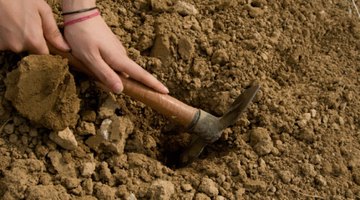Excavating Techniques
"There is no right way of digging, but there are many wrong ways," wrote renowned archaeologist, Sir Mortimer Wheeler. This quote gives you an idea of the complexities associated with an excavation site.

Archaeology may bring to mind dramatic discoveries, such as the tomb of Tutankhamen, or scenes from an Indiana Jones movie. Yet, in reality archaeology is more often a painstaking and tedious record of carefully designed excavations. Ancient objects are usually fragile and buried deep underground. Archaeologists must use excavation techniques that grant them access to archaeological remains without breaking, damaging or contaminating the site.
Shoveling and Screeing
Most excavation teams use sharp skim shovels. These shallow shovels are used to carefully scrape the excavation and slowly peal thin layers of earth. Archaeologists using this technique will be looking out for soil changes and artifacts. Once the soil is removed from the site it is screened with meshes to recover small artifacts field researchers may have missed.
Troweling
Archaeologists will often use trowels, wooden picks or even pain brushes instead of shovels when they are working on a site where there is a high probability of finding artifacts or other ancient remains. These tools allow diggers to have a better feel for the changes in the soil and help reduce the risk of damaging an artifact.
Vertical Excavations
Vertical excavation techniques are used to expose layers of strata in urban sites which have been occupied during multiple time periods. One vertical excavating method, the Wheeler Box Grid system creates a grid of excavated square areas while the rest of the excavation are is left intact. This allows the study of the succession of cultures or time-scale of a particular culture without being too invasive on other important features of an excavation.
Horizontal Excavations
Horizontal excavations are used to uncover large sections of a site. Although more invasive than vertical excavations, it allows a more in-depth study of a site's layout and function that other excavating techniques cannot offer. Vertical and horizontal excavation techniques complement each other and are often used on the same site at different times to provide a broader understanding of the site's function and time-scale.
References
Writer Bio
Andrew Latham has worked as a professional copywriter since 2005 and is the owner of LanguageVox, a Spanish and English language services provider. His work has been published in "Property News" and on the San Francisco Chronicle's website, SFGate. Latham holds a Bachelor of Science in English and a diploma in linguistics from Open University.
Photo Credits
- Jupiterimages/Photos.com/Getty Images
- Jupiterimages/Photos.com/Getty Images
More Articles



